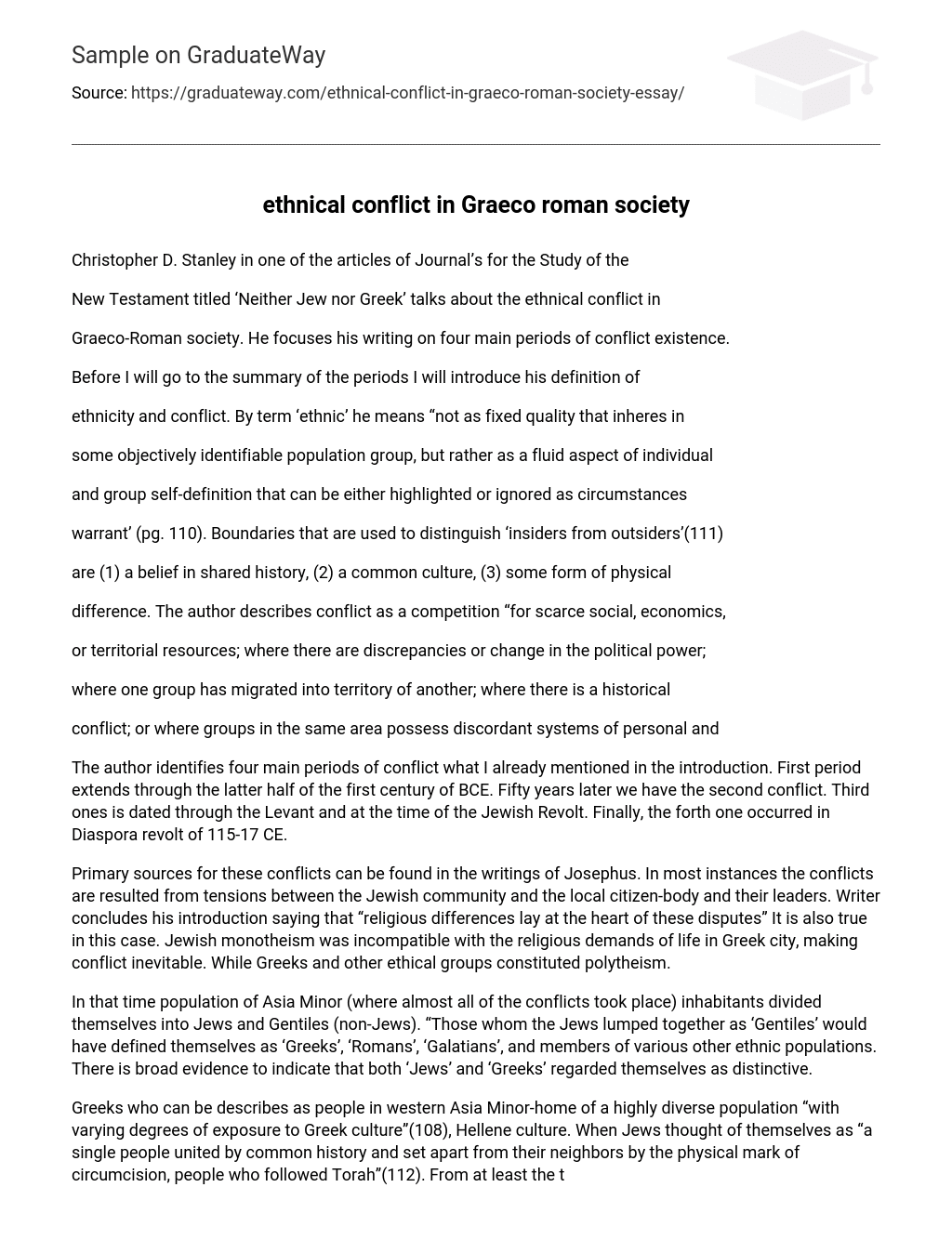In his article titled ‘Neither Jew nor Greek’ for the Journal for the Study of the New Testament, Christopher D. Stanley examines ethnical conflict in Graeco-Roman society. He categorizes four primary periods of conflict and presents his definition of ethnicity and conflict before providing an overview of these time periods.
Stanley argues that ethnicity is not a static characteristic, but rather a flexible component of how individuals and groups define themselves, which can be emphasized or disregarded based on the situation (pg. 110).
The author explains that boundaries used to differentiate between insiders and outsiders involve shared history, a shared culture, and some physical differences. Conflict arises in situations where there is competition for limited social, economic, or territorial resources, a shift in political power, migration of one group into another’s territory, historical conflicts, or differing systems of beliefs among groups in the same area.
The author discusses four main periods of conflict, as mentioned in the introduction. The first period spans the latter half of the first century BCE. Fifty years later, the second conflict occurs. The third conflict takes place in the Levant during the time of the Jewish Revolt. Finally, the fourth conflict happens during the Diaspora revolt of 115-17 CE.
Josephus’ writings offer primary sources on the conflicts that emerged between the Jewish community and the local citizens and their leaders. These tensions primarily arose from religious disparities, which formed the core of these disputes. The clash was unavoidable as Jewish monotheism clashed with the polytheistic beliefs held by Greeks and other ethnic groups residing in Greek cities.
During that period, the population of Asia Minor was segregated into two categories: Jews and Gentiles (non-Jews). The Gentiles, known as ‘Greeks’, ‘Romans’, ‘Galatians’, or members of other ethnicities, were identified as such by the Jews. Both Jewish and Greek communities took pride in their unique identities.
The Hellene culture in western Asia Minor had a variety of backgrounds and levels of familiarity with Greek customs. On the other hand, the Jews saw themselves as a united community with a unique history and dedication to Torah, which included circumcision. From the third century BCE onwards, Greek and Jewish communities peacefully coexisted until the end of the first century BCE.
The author claims that the Greeks in Asia Minor oppressed the Jews by preventing them from practicing their religious laws and forcing them to attend court on the Sabbath. The Greeks also confiscated funds raised by the Jews for the Jerusalem Temple and drafted their sons into military service. Furthermore, some Jews had to use their own money for public services. The Jews believed that everything they owned was given to them by God and felt unable to challenge these practices, which clashed with Greek cultural biases. However, the Greeks did not see any reason to respect these beliefs and practices because they contradicted their own identity.
One reason for the growth of conflict was the political relationship between the two groups. After migrating to Asia Minor, the Greek population began to feel privileged when they outnumbered the Jewish population. As a result, the increase in Jewish immigrants from Palestine became a concern for the Greeks, as their residence and status relied on the goodwill of the citizen body. The Jewish community always needed permission from authorities for various activities such as holding public meetings, running food markets, and owning property.
The author discusses another reason for the shortage of currency. During a time when currency was scarce, exporting money from the city only worsened the economic hardship. This led civic officials to ban such transfers and seize Jewish funds in an attempt to resolve an economic crisis (119). This occurred simultaneously with the Roman Civil Wars, which forced Greek cities to divert significant resources towards competing with the Roman armies. As a result of the shortage of money, they had to discontinue the practice of sending funds to Judea to support the Jerusalem Temple.
The emergence of ethical conflicts in Greece-Roman society was influenced by cultural, relational, and political differences. The economic situation also played a role. Moreover, it is worth mentioning that Jewish communities in the Asian region have been involved in ethical conflicts, even as recently as the 20th century.
Reading the article improved my comprehension of the historical context portrayed in the Gospels. It enabled me to grasp the importance of both event chronology and ethnic conflicts, as well as recognizing the crucial need for a leader who could liberate the Jewish community from their oppressors. The Gospel writers referred to this awaited figure as “Survivor” or “Messiah”. Their longing for him stemmed from a deep desire to attain freedom from cultural, religious, and political constraints in order to alleviate their ongoing hardships.
The topic of the article is relatable to the readings from the Gospels, given that ethical conflict has been a significant source for biblical writings, particularly in the New Testament.





